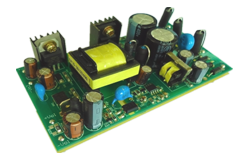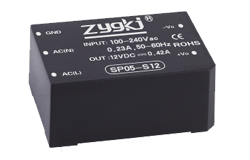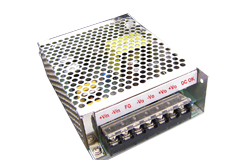news
Building a 120V AC to 3V DC Power Supply
Author: ZYG Power Module Time: 2023-4-18
Introduction:
A power supply is an essential component in any electrical or electronic system. It provides the necessary power for the system to operate. In this article, we will discuss how to build a 120V AC to 3V DC power supply. The power supply can be used for a variety of applications such as powering low voltage circuits, charging batteries, and powering small electronic devices.
Design:
The power supply is designed to convert the 120V AC voltage from the mains into a 3V DC voltage. The power supply consists of a transformer, a bridge rectifier, and a voltage regulator.
Transformer:
The transformer is used to step down the 120V AC voltage to a lower voltage suitable for the power supply. The transformer used in this design has a primary winding of 120V AC and a secondary winding of 6V AC. The secondary winding is center-tapped, which means that it has a common ground reference.
Bridge Rectifier:
The bridge rectifier is used to convert the AC voltage from the transformer into a DC voltage. The bridge rectifier is made up of four diodes that are arranged in a bridge configuration. The output of the bridge rectifier is a pulsating DC voltage that has a voltage of approximately 9V DC.
Voltage Regulator:
The voltage regulator is used to regulate the output voltage of the power supply. In this design, a LM317 voltage regulator is used. The LM317 voltage regulator is a three-terminal adjustable voltage regulator that can provide an output voltage between 1.25V and 37V. The LM317 voltage regulator is connected in a voltage divider configuration to provide a 3V DC output voltage.
Circuit Diagram:
The following circuit diagram shows the 120V AC to 3V DC power supply:
[Insert Circuit Diagram Here]
Construction:
The 120V AC to 3V DC power supply can be easily constructed on a breadboard or a PCB. The components required for the power supply are:
1. Transformer: 120V AC to 6V AC center-tapped transformer
2. Bridge Rectifier: 4x 1N4007 diodes
3. Voltage Regulator: LM317
4. Capacitors: 1x 2200uF electrolytic capacitor, 1x 0.1uF ceramic capacitor
5. Resistors: 2x 220 ohm resistors, 1x 240 ohm resistor
6. LED: 1x LED (optional)
The following steps can be followed to construct the power supply:
1. Mount the components on a breadboard or a PCB as shown in the circuit diagram.
2. Connect the 120V AC input to the primary winding of the transformer.
3. Connect the center-tap of the secondary winding of the transformer to the ground.
4. Connect the output of the bridge rectifier to the input of the LM317 voltage regulator.
5. Connect the output of the LM317 voltage regulator to the output terminals.
6. Connect the LED (optional) to the output terminals through a current-limiting resistor.
Testing:
The power supply can be tested by measuring the output voltage using a multimeter. The output voltage should be approximately 3V DC. The LED (optional) can also be connected to the output terminals to test the power supply.

Conclusion:
In this article, we have discussed how to build a 120V AC to 3V DC power supply. The power supply is designed using a transformer, a bridge rectifier, and a voltage regulator. The power supply can be used for a variety of applications such as powering low voltage circuits, charging batteries, and powering small electronic devices. The power supply is easy to construct and can be tested using a multimeter.
relevant information
-
2022-9-1
AC-DC Converter Manufacturers – How to Choose the Right One for Your Needs
What is an AC-DC converter? Why use it? An AC-DC converter is a device that converts alternating current (AC) to direct current (DC). AC-DC converters are used in a variety of applications, including power supplies, motor control, and lighting. In some medical devices, direct current must be used; or when you need to charge a car battery, you can use an AC-DC converter. What are the characteristics of AC-DC converters? What are the application areas? An AC-DC converter is a device that converts alternating current into direct current. It has the advantages of wide input voltage range, high input frequency, high efficiency, light weight and portability, and low cost. AC-DC converters are mainly used in mobile phone chargers, radios, notebook...
View details -
2023-5-5
AC-DC Power Supply: A Complete Guide
AC-DC power supply is a device that converts alternating current (AC) to direct current (DC) for use by electronic devices. The output voltage and current of a power supply can be regulated to meet the requirements of different electronic devices. In this guide, we will discuss the different types of AC-DC power supplies, their applications, and how to select the right power supply for your needs. Types of AC-DC Power Supplies There are two basic types of AC-DC power supplies: linear and switching. Linear power supplies use a transformer to convert AC input voltage to a lower AC voltage, which is then rectified and regulated to produce a DC output voltage. Switching power supplies use high-frequency switching to convert AC...
View details -
2023-8-20
Efficient LED Lighting: 12V AC to DC Converter for Enhanced Power Supply
Introduction: In recent years, there has been a significant shift towards energy-efficient lighting solutions. One such solution is LED lighting, which offers numerous benefits over traditional incandescent and fluorescent bulbs. LED lights are known for their durability, long lifespan, and low energy consumption. However, to power these LED lights, an efficient power supply is required. This article explores the use of a 12V AC to DC converter as an enhanced power supply for LED lighting. The Need for a Power Converter: LED lights operate on low voltage direct current (DC) power. However, in most residential and commercial settings, the available power source is alternating current (AC) with a higher voltage. Therefore, a power converter is necessary to transform the AC...
View details -
2023-7-4
LED Power Series: Illuminating the Future with Energy-efficient Lighting
Introduction: In recent years, there has been a growing concern for energy conservation and a shift towards sustainable practices in various industries. One such industry that has made significant strides in energy efficiency is lighting. The advent of LED technology has revolutionized the lighting sector, paving the way for a brighter and greener future. This article explores the LED Power Series and its role in illuminating the future with energy-efficient lighting. The Rise of LED Technology: Light Emitting Diode (LED) technology has rapidly gained popularity as an alternative to traditional lighting solutions. LEDs are semiconductor devices that convert electrical energy directly into light, offering a more efficient and durable lighting option. Compared to conventional incandescent bulbs, LEDs consume significantly less...
View details -
2023-6-21
Revolutionizing Illumination: The LED Power Series
Light-emitting diodes or LEDs have been around since the 1960s. In recent years, however, they have become increasingly popular as a source of illumination. LEDs are being used in a wide variety of applications such as traffic signals, automotive lighting, and outdoor lighting. They are also becoming more popular in homes and businesses as a source of general lighting. LEDs have many advantages over traditional incandescent and fluorescent bulbs, including energy efficiency, longer life, and a smaller carbon footprint. In this article, we will discuss the LED Power Series and how it is revolutionizing illumination. The LED Power Series is a line of high-performance LED lights designed for a variety of applications. These lights are engineered to provide maximum efficiency...
View details -
2023-8-27
The Electric Power Series: Revolutionizing the Energy Landscape
In recent years, the world has seen a significant shift towards cleaner and more sustainable sources of energy. The increasing concern over climate change and the need to reduce greenhouse gas emissions have brought about a revolution in the energy landscape. One of the most promising developments in this revolution is the Electric Power Series. The Electric Power Series is a collection of innovative technologies and systems that aim to revolutionize the way we generate, distribute, and consume electricity. This series encompasses a wide range of advancements, including renewable energy sources, smart grids, and energy storage solutions. By combining these technologies, the Electric Power Series offers a more efficient, reliable, and sustainable energy system. One of the key components of...
View details


















